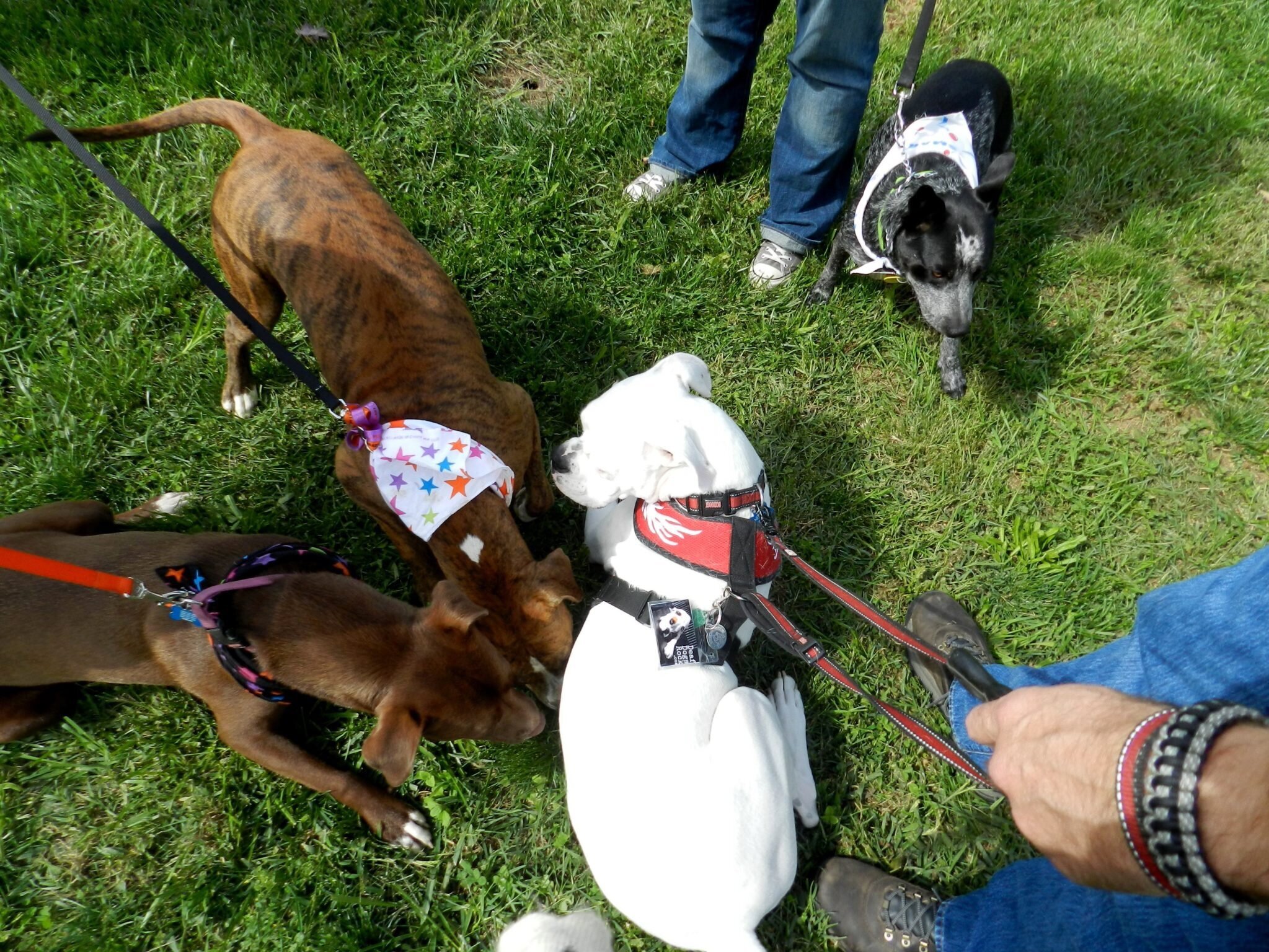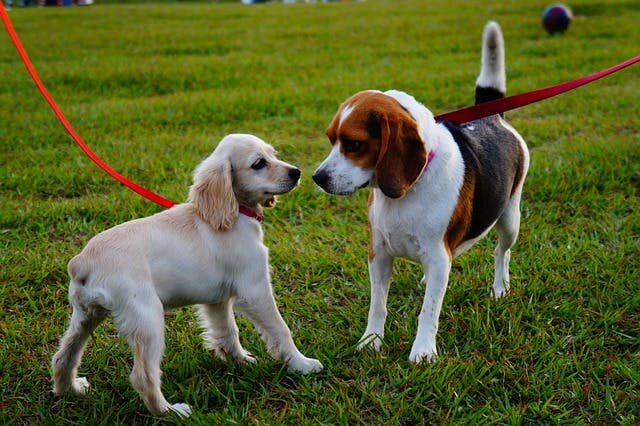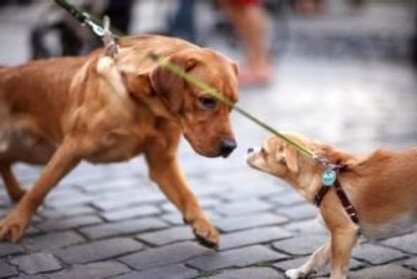Doggy Dates: How To Introduce Dogs
It should come as no surprise that dogs are social creatures.
In addition to interacting with their humans, most dogs need and greatly benefit from time interacting with members of their own species. Regular access to play can help reduce undesirable behaviors like destructive chewing, mouthing, and hyperactivity and good dog play can foster skills such as improved physical coordination, problem-solving, and confidence.
However, all interactions are not created equal, and getting it wrong can result in increased social anxiety, aggression and the development of poor social skills.
This article will explore some common dog-dog interactions, rated from the least to the most constructive for Fido.
SAY NO TO ON LEASH GREETINGS
On leash greetings are one of the most popular ways for dogs to meet other dogs, yet they come with a whole host of shortcomings and behavioral side effects that often go undiscussed.
Firstly, dogs prefer to greet by curving to approach each other in a long, slow arc as opposed to going up to each other face-to-face. To dogs, a face-to-face greeting is at its best, rude, and at its worst, threatening. The human equivalent would look like a person greeting someone for the first time by sticking their face in another person’s and planting a big kiss on their lips, instead of giving them a customary, introductory handshake.
The nature of the leash restricts our dogs’ ability to greet naturally. Since a frontal approach is considered more threatening, this can set the dog who is being approached to feel defensive towards the approaching dog before the greeting even occurs. This makes aggression during the ensuing encounter more likely.
Secondly, dogs intuit important social information by sniffing each other’s butts. This is a complicated process to maneuver with leashes; they almost always end up tangled. If one or both dogs want to move away from the interaction, they can soon find that this option is limited. When dogs panic and their flight option is limited, they may resort to fighting to get the distance that they need to feel safe.
Even if both dogs are friendly, there are still reasons to not allow them to meet on leash. Chances are that your dog is either pulling, planting, or even laying down to get closer to their new dog friend. By allowing your dog to greet when they are exhibiting these behaviors, you will reinforce them, making them much more likely to occur again in this context. This can make going on a walk challenging, particularly if you live in an urban environment where there are dogs on every block.
It is common for most dogs to have had at least one bad experience greeting on leash. Some dogs emerge unscathed, but other dogs, particularly those in their sensitive periods for socialization (like puppies or adolescents) can be more likely to exhibit fear when they see dogs in the future. This fear can lead to dogs exhibiting more aggressive behaviors like barking, air-snapping, and lunging in a preemptive attempt to keep others away.
DON’T DO THE DOG PARK
Avoidance behaviors, or cut off signals often go ignored in raucous dog park environments
The dog park is the natural choice for dog guardians seeking more “legitimate” venues for their dogs to socialize with others. But as is the case with on-leash greetings, there is a lot of potential fallout that lead us to conclude that dog parks are not the best places for Fido to get to know other dogs.
Dog parks are highly unregulated and inconsistent spaces; there are no checks on who is and isn’t allowed to enter and the day-to-day crowd is always changing. Dogs in off-leash environments should at very minimum, possess the ability to respond to cutoff signals appropriately. Cutoff signals are body language displays that communicate that a dog is uninterested or uncomfortable with elements of an interaction. They are give However, a lot of the dogs in dog parks are not socially-savvy and continue to escalate their play attempts by jumping, biting, and humping despite other dogs giving off clear cutoff signals.
The sheer volume of dogs at the dog park can further complicate this matter. Multiple dogs can gang up on one dog, which can very quickly turn a fun play session into an all-out bully battle. And if one dog is not getting the attention that they want from another because they are already engaged in play, they can quickly resort to more pushy behaviors to get attention.
All these interactions can very quickly bubble over into full-on fights without human intervention. Yet, many dog guardians at dog parks are preoccupied by activities such as chatting on the phones or with other dog parents. Even if they are supervising, many are uneducated in the minutiae of dog body language and do not see any problems with their dogs’ play. If they do see problems, a lot of people are perfectly content to let the dogs work it out on their own. However, as anyone who has ever bore witness to a fight at a dog park may know, letting unknown dogs sort things out amongst themselves can lead to some dangerous outcomes for all dogs and humans involved
ONE ON ONE IS A WINNER
Learning to read dog body langauge is key to facilitating healthy play
The truth is that most dogs prefer to interact in groups of two. That is why many will naturally peel off into pairs at the dog park or at large group puppy socials. It is much easier for dogs to be attentive and responsive to one other dog's social cues versus those of twelve or twenty dogs.
For this reason, we recommend that our clients prioritize planned, one-on-one playdates for their dogs above all other interactions. This kind of format can help ensure that their dog is appropriately matched in play, to the end of avoiding any major communication snafus. Even if they are not perfectly matched, people can help their dog make better decisions in a more controlled environment where they know both the dog and human involved.
We often recommend setting up playdates in large, open spaces like nearby parks, sports fields, or even empty basketball and handball courts. Depending on where people live, they might even be able to rent out a private yard or field for their pups and their friends to run around in. Wide open spaces offer dogs a greater ability to take breaks from one another if they get over aroused, which will help keep play from tipping over into aggression. If the dogs do not have a great recall, guardians can purchase a long line to drag behind them as they run around as an additional security measure. An added benefit of one-on-one playdates is that they offer guardians a great opportunity to proof their dog's cues to the most distracting distraction of all—other dogs!
WALKING TOGETHER IS BETTER
Some dogs require slow introductions in a natural/neutral environment
Going for a tandem walk together is another great and underrated way for dogs to interact, particularly if one dog is not as interested in playing as the other or if both tend to get easily over aroused during play.
A tandem walk involves two handlers walking with their dogs (preferably on long lines) at a distance from one another in as natural an environment as possible. Handlers can choose to maintain a large distance between the dogs for the entirety of the walk or bring their dogs closer together for certain periods of time to interact – depending on how comfortable both dogs are with this -- before splitting off again.
Check out this video from Bravo Dog demoing appropriate low stress introductions
This kind of walk can help teach easily excited dogs to exist around other dogs without constantly needing to play. Instead, they are offered alternative ways to self-regulate such as moving their bodies through nature, interacting with the environment, and sniffing.
Tandem walks can also give more nervous dogs the opportunity to observe known, neutral dogs from a distance. Guardians can then use counterconditioning techniques to help their dogs learn that other dogs are safe and predictable under the guidance of a trainer.
PLAY SMART
Although they may be the easiest, dog parks and on leash greetings are not the best ways for your dogs to get the one-on-one time that they are craving with their canine counterparts. If you want to keep your dog safe and be certain that they are practicing polite play behaviors, consider setting up one-on-one interactions with known dogs and their guardians instead.
At CCA, we offer our existing clients access to a community database where they can find appropriate playmates or stooge dogs to train around in their area. Please send an email to info@calmcanineacademy.com if you are or have been a client of ours and are interested in receiving this link.
Online platforms such as Facebook, Meetup, and Nextdoor can also be useful for finding doggie playdates in your area. Of course you will want to vet potential playmates thoroughly before meeting up to make sure that your needs, goals, and training practices are a good fit.
Finally, if your dog is exhibiting any concerning behavior during their interactions with other dogs and you are unsure about how to proceed, we recommend reaching out to schedule a private session with one of our certified trainers.





